
Ghost Pond Update
Surveying for newts and insects



Great Crested Newt Survey
We start at the end of a record breaking hot June when Jilly from FWAG came to take water samples from the ghost ponds in the Outback.
You can see that the water has dropped dramatically and on the 21st of June only a puddle was left in one pond, Little Owl Pond (above). The other two had faired better but still there was not much water left.
Jilly was testing for the DNA for Great Crested Newts, the ponds were constructed for them. We built hibernaculars and the ponds are positioned to ensure there is no contimination from sprays from neighouring fields. Our endangered Great Crested Newt needs clean water. We await the resuts…….
Barn Owl Pond (right)
Surveying for Invertebrates.
The invertebrate survey was carried out by Alex, a student at Writtle studying Animal Science. He loves ponds and particulary frogs and applied his knowledge brilliantly. Thankyou!
By the 14th of July the water in the pond had dropped further. We could not survey Little Owl Pond at all and there was only a puddle left in Barn Owl Pond, as you can see below left and centre, but there was life and it was recorded. (left & central image)
Our eastern most pond in the Outback, Chicory Pond (because I found the first Chicory plant there), did have water!
Alex also surveyed Dooleys and Home Pond.

A bit of back ground from Alex because every day is a school day!
- Regarding the scoring systems the number goes alongside the water quality that the invertebrate requires. That’s why it’s used as a biological scoring method of pollution, the invertebrates with higher numbers won’t be found in polluted water.
- Level of light intensity on ponds will effect the flora species and growth which influences the fauna species.








